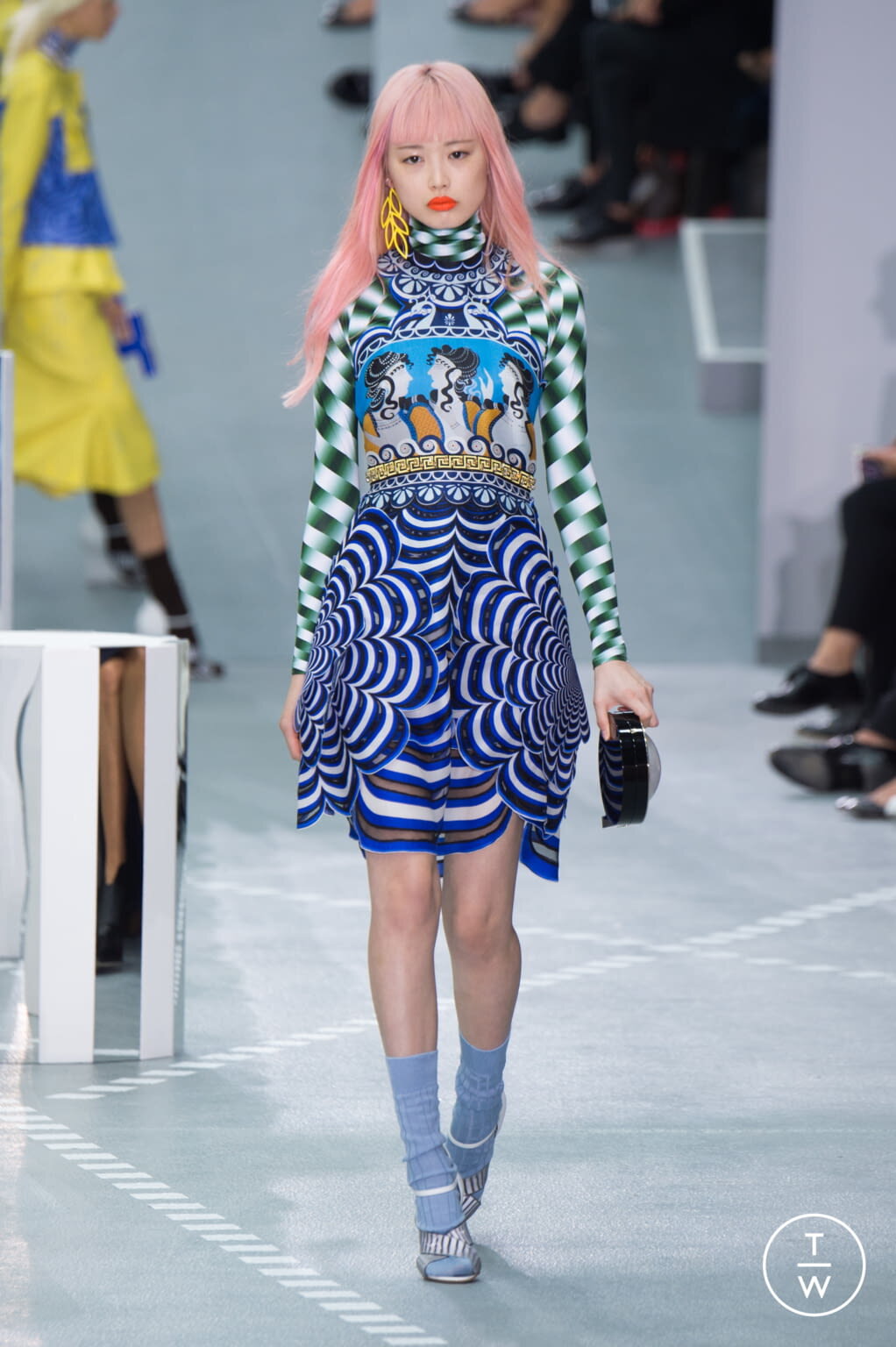The Minoan in Mary Katrantzou
Greek designer Mary Katrantzou has often allowed the famed past of her home country to inform her designs. For her SS17 collection, Katrantzou looked to the Bronze Age, rather than the more popularly known Classical period. In this collection, the designer took inspiration from the colourful frescoes in the palace of Knossos and combined them with the trompe l’oeil (translates to ‘deceive the eye’ – so optical illusion) prints she has become renowned for, as well as the shapes and colours of the Swinging Sixties.
The Minoan period took place in the 3rd to 2nd millennia BC. So, a very, very long time ago. As a result, the evidence is fragmentary and often difficult to interpret. That was until Arthur Evans began to excavate the palace of Knossos in Crete in 1899, and over 25 years undertook heavy restorations of the architecture and artwork found there. This now proves controversial, but to Evans at the time it appeared to be a completely acceptable pursuit – and it provided revenue for him to continue his work. The name ‘Minoan’ also came from Evans, who believed Knossos was the palace of the mythological King Minos, who built the labyrinth and whose unfortunate wife Pasiphae was the mother of the Minotaur that resided within it. This theory has been proven impossible, but we can see why Evans saw this as a possibility – bull imagery is very popular, and often the architecture of the Minoan Palaces appears complex and labyrinthine. As Katrantzou was inspired in this collection by a childhood visit to Knossos, it is more likely that the vivid recreations of the frescoes by Evans and his team are what caught her eye – rather than the genuine remains of the Bronze Age civilisation.
A popular conception about Minoan society – though difficult to prove – is that it was a matriarchy. Wall paintings of beautiful women with elaborate hairstyles and detailed, flounced dresses that left their breasts exposed (which I wish was societally acceptable today), as well as the many faience figurines of the Snake Goddess with the same characteristics would lead a viewer to believe women played an important part in society.
Snake Goddess from the palace at Knossos, c. 1600 B.C.E., majolica, 29.5 cm high (Archaeological Museum of Heraklion, photo: Zde, CC BY-SA 4.0)
It is now believed that women were most likely instrumental in matters of religion, rather than state, but nevertheless, these beautiful depictions of women are used by Katrantzou to emphasise the female presence in her SS17 collection.
One of these paintings of women is the “Ladies in Blue” fresco, which can now be viewed in the Heraklion Archaeological Museum in Crete. This heavily restored work is directly quoted in Look 21, forming the bodice of a slim-line dress.
Look 21, Mary Katrantzou SS17 https://www.marykatrantzou.com/collections/spring-summer-2017/
The skirt of the dress is made up of blue and white wave patterns, which echo the nautical aspect of the Minoan society. One of the Ladies in Blue also appears on her own on the more formal looks towards the end of the collection – including Look 28, which also incorporates the cerulean blue that recalls the colour of the Mediterranean Sea.
Another Minoan motif that Katrantzou borrows is the processional imagery from the Corridor of Processions at Knossos. This painting shows men and women walking in line, set against a colourful, striped backdrop, carrying offerings to a female figure that resembles the Snake Goddess. The version from Knossos appears directly in Look 10, the ochre-skinned men parading across the thigh of the model.
Look 10, Mary Katrantzou SS17 https://www.marykatrantzou.com/collections/spring-summer-2017/
In Look 12, a variation of this theme occurs across the knee of a figure-hugging midi dress – but this image is of Mycenaean origin, another Bronze Age society from mainland Greece. The fresco is complemented by repetitive bands of laurel patterns and Greek meander, as well as more abstract patterns that bring the colours of the fresco into other parts of the dress. The motif of the processional is extremely fitting for Katrantzou’s purpose, as what else is a runway if not a procession in itself.
Although Katrantzou’s main inspiration is Minoan, she definitely isn’t strict with her adherence to this theme, also using Mycenaean works as mentioned above, and Archaic black-figure vases, which were created about 1,000 years after Knossos was built. There are countless tracts of art theory about the effect of reproducing works of art (see Walter Benjamin and John Berger if you want to be mind-boggled), but in my opinion, Katrantzou has managed to bring a vitality and momentum to Minoan culture through her design. She has rejuvenated the ancient wall paintings of a Bronze Age society and converted them to her own medium – textiles and fashion, to be seen at London Fashion Week.


